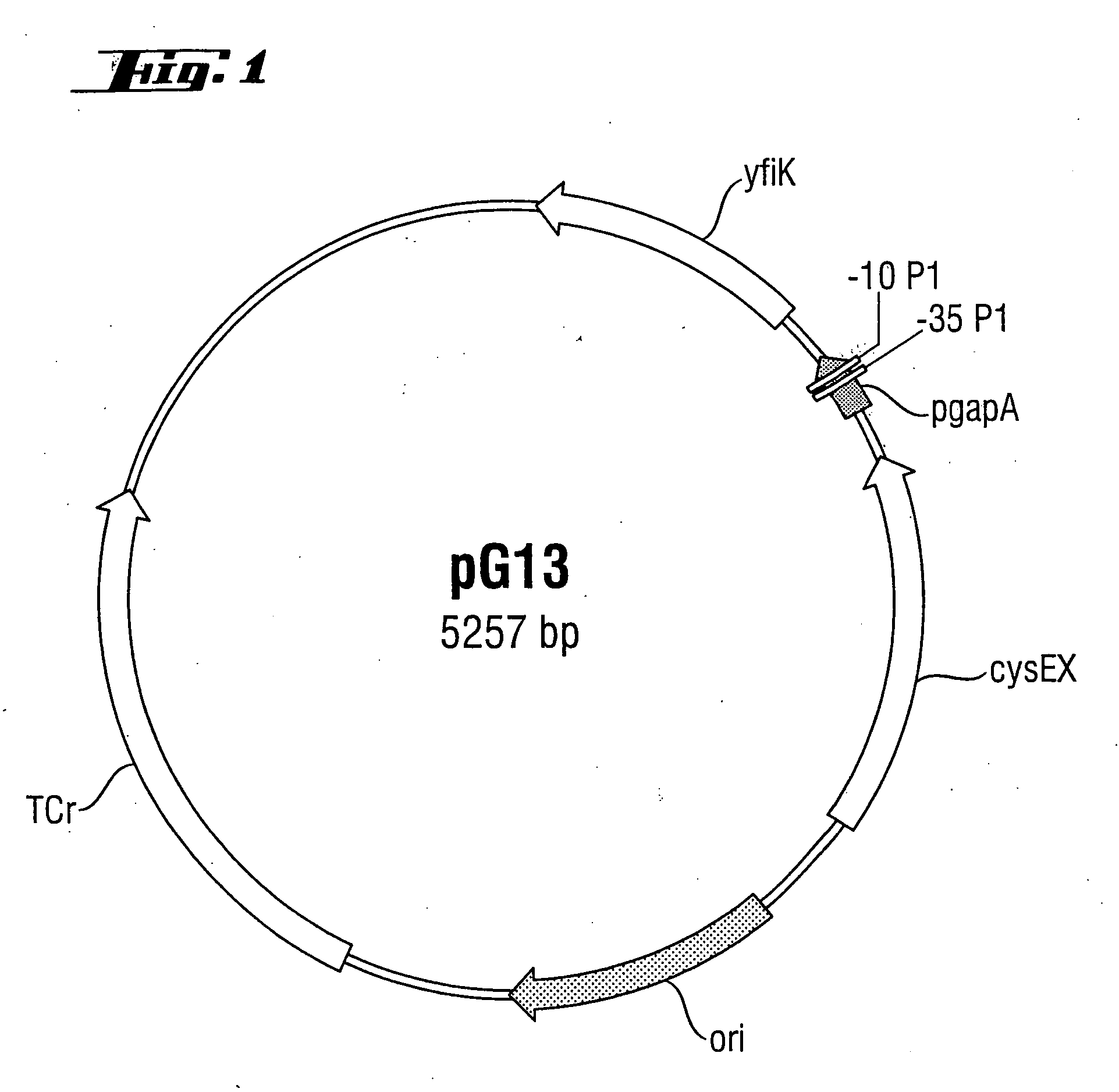Method for fermentative production of amino acids and amino acid derivatives of the phosphoglycerate family
a technology of phosphoglycerate which is applied in the field of fermentation production of amino acids and amino acid derivatives of the phosphoglycerate family, can solve the problems of not being able to assign a physiological function to the yfik gene, and being absolutely impossible for the skilled worker to draw conclusions therefrom about concrete amino acid substrates of said yfik protein
- Summary
- Abstract
- Description
- Claims
- Application Information
AI Technical Summary
Benefits of technology
Problems solved by technology
Method used
Image
Examples
example 1
[0064] The yfiK gene from Escherichia coli strain W3110 was amplified with the aid of polymerase chain reaction. The specific primers used were the oligonucleotides yfiK-fw: [0065] 5′-(SEQ. ID. NO: 3)-3′and [0066] yfiK-rev: [0067] 5′-(SEQ. ID. NO: 4)-3′.
[0068] The resulting DNA fragment was digested by the restriction enzymes AsnI and PacI, purified with the aid of agarose gel electrophoresis and isolated (Qiaquick® Gel Extraction Kit, Qiagen, Hilden, D). Qiaquick® is a trademark for a DNA extraction kit. Cloning was carried out by way of ligation with an NdeI / PacI-cut vector pACYC184-cysEX-GAPDH which has been described in detail in EP0885962A1. This vector contains a cysEX gene coding for a serine acetyl transferase with reduced feedback inhibition by L-cysteine and, 3′ thereof, the constitutive GAPDH promoter of the gapA gene. Said procedure places the yfiK gene downstream of the GAPDH promoter in such a way that transcription can be initiated therefrom....
example 2
Producer Strain Preculture
[0069] A preculture for the fermentation was prepared by inoculating 20 ml of LB medium (10 g / l tryptone, 5 g / l yeast extract, 10 g / l NaCl), which additionally contained 15 mg / l tetracycline, with the strain W3110 / pG13 or W3110 / pACYC184-cysEX and incubation in a shaker at 150 rpm and 30° C. After seven hours, the entire mixture was transferred into 100 ml of SM1 medium (12 g / l K2HPQ4; 3 g / l KH2PO4; 5 g / l (NH4)2SO4; 0.3 g / l MgSO4×7 H2O; 0.015 g / l CaCl2×2 H2O; 0.002 g / l FeSO4×7 H2O; 1 g / l Na3citrate×2 H2O; 0.1 g / l NaCl; 1 ml / l trace element solution comprising 0.15 g / l Na2MoO4×2 H2O; 2.5 g / l Na3BO3; 0.7 g / l CoCl2×6 HO; 0.25 g / l CuSO4×5 H2O; 1.6 g / l MnCl2×4 H2O; 0.3 g / l ZnSO4×7 H2O), supplemented with 5 g / l glucose, 0.5 mg / l vitamin B1 and 15 mg / l tetracycline. Further incubation was carried out at 30° C. and 150 rpm for 17 hours.
example 3
Fermentative Production of O-acetyl-L-serine
[0070] The fermenter used was a Biostat® M instrument from Braun Biotech (Melsungen, D), which has a maximum culture volume of 2 1. Biostat® is a trademark for a fermenter. The fermenter containing 900 ml of SM1 medium supplemented with 15 g / l glucose, 0.1 g / l tryptone, 0.05 g / l yeast extract, 0.5 mg / l vitamin B1 and 15 mg / l tetracycline was inoculated with the preculture described in example 2 (optical density at 600 nm: approx. 3). During fermentation, the temperature was adjusted to 32° C. and the pH was kept constant at 6.0 by metering in 25% ammonia. The culture was gassed with sterilized compressed air at 1.5 vol / vol / min and stirred at a rotational speed of 200 rpm. After oxygen saturation had decreased to a value of 50%, the rotational speed was increased to up to 1 200 rpm via a control device in order to maintain 50% oxygen saturation (determined by a pO2 probe calibrated to 100% saturation at 900 rpm). As soon as the glucose con...
PUM
| Property | Measurement | Unit |
|---|---|---|
| Fraction | aaaaa | aaaaa |
| Density | aaaaa | aaaaa |
| Density | aaaaa | aaaaa |
Abstract
Description
Claims
Application Information
 Login to View More
Login to View More - R&D
- Intellectual Property
- Life Sciences
- Materials
- Tech Scout
- Unparalleled Data Quality
- Higher Quality Content
- 60% Fewer Hallucinations
Browse by: Latest US Patents, China's latest patents, Technical Efficacy Thesaurus, Application Domain, Technology Topic, Popular Technical Reports.
© 2025 PatSnap. All rights reserved.Legal|Privacy policy|Modern Slavery Act Transparency Statement|Sitemap|About US| Contact US: help@patsnap.com

